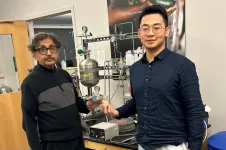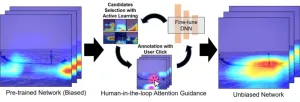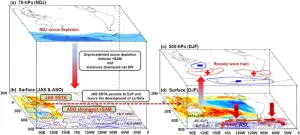(Press-News.org)
Some species of mussels can see. Scallops, for example, have up to 200 eyes that help them detect predators such as an approaching starfish. However, the eyes of scallops differ significantly from the human eye. While in our eyes the combination of cornea and lens creates an image on the retina, in scallop eyes light is focused by a hemispherical mirror.
Optical imaging with lenses or mirrors
Creating images with mirrors instead of lenses is especially common in astronomical telescopes, in order to capture as much light as possible from planets, stars and galaxies. In the Schmidt telescope developed in the 1930s by Bernhard Schmidt (1879-1935) and still in use in many observatories today, a thin corrective lens is combined with a large spherical mirror.
Mirror objectives are rarely found, however, in microscopes used to study the biological microcosmos. Most microscope objectives are so compact that they can easily be assembled from lenses. However, to achieve the highest image quality, 10 to 15 lenses made of different types of glass are required, all of which must be precisely polished and accurately aligned with each other. As a result, the cost of microscope objectives for research can be equivalent to that of a medium-sized car, representing a significant portion of the total cost of a microscope.
Compatibility with different immersion media as stumbling block
In addition to their complex design, many commercial objectives have the disadvantage that they are usually designed for one specific immersion medium only, such as air, water or oil. This means that a new objective must be purchased for samples requiring a different immersion medium. For a long time, this was not a major problem, but in recent years, processes known as clearing techniques that can make tissue samples transparent have attracted a lot of interest in biology and pathology. For example, instead of laboriously preparing thin tissue slices from a removed mouse brain, clearing techniques can make the whole brain transparent. In pathology, the hope is that clearing techniques will increase the efficiency of biopsy-specimen examinations, making it possible to diagnose malignant tissue changes such as tumors earlier, for example. Unfortunately, however, most clearing techniques use immersion media that are incompatible with conventional microscope objectives. This means the considerable advantages of clearing techniques for research remain partially untapped.
High-resolution microscopy in large transparent tissue blocks
To circumvent the limitations of conventional microscope objectives, and inspired by the eyes of scallops, which in principle function like small underwater Schmidt telescopes, UZH neuroscientist and amateur astronomer Dr. Fabian Voigt developed an unconventional approach: he realized that it was possible to fill a Schmidt telescope with a liquid immersion medium and shrink it to the size of a microscope. The resulting objective is quasi a miniature telescope that has been submerged and still provides a sharp image. “It is possible to design a Schmidt objective in a way that it provides excellent image quality in any homogeneous fluid as well as in air,” says Voigt. This means that a single Schmidt objective is compatible with many different clearing techniques. The reason for this unusual feature is the use of a mirror instead of lenses. A spherical mirror focuses light at the same point whether it is immersed in liquid or is in the air.
Versatile applications also in medical diagnostics
To demonstrate the versatility of this innovative approach, researchers working with Fabian Voigt and UZH professor Fritjof Helmchen used their prototype Schmidt objective to study a variety of samples, including mouse brains, tadpoles and chicken embryos. Together with a team from Maastricht University, they were also able to analyze cleared human brain samples. In addition, the new type of objective is also suitable for measuring neuronal activity in the brains of live young zebrafish larvae. “In all cases, the image quality was equivalent to or even better than that achievable with conventional objectives – even though the Schmidt objective consists of only two optical elements,” Helmchen explains. Compared to conventional objectives, which have about a dozen more lenses, a Schmidt objective can therefore be manufactured much more cost-effectively.
Future applications could also include the examination of tumor tissues or the detection of neurological diseases. “In this respect, scallops could show us the way to improved medical diagnostics,” says Helmchen.
END
Lehigh Engineering researcher Arup SenGupta has developed a novel way to capture carbon dioxide from the air and store it in the “infinite sink” of the ocean.
The approach uses an innovative copper-containing polymeric filter and essentially converts CO2 into sodium bicarbonate (aka baking soda) that can be released harmlessly into the ocean. This new hybrid material, or filter, is called DeCarbonHIX (i.e., decarbonization through hybrid ion exchange material), and is described in a paper recently published in the journal Science Advances.
The research, which demonstrated a 300 percent increase in the amount of carbon captured ...
About The Study: In this updated systematic review and meta-analysis of 107 studies involving more than 4.8 million participants, daily low or moderate alcohol intake was not significantly associated with all-cause mortality risk, while increased risk was evident at higher consumption levels, starting at lower levels for women than men.
Authors: Jinhui Zhao, Ph.D., of the University of Victoria in Victoria, British Columbia, Canada, is the corresponding author.
To access the embargoed study: Visit our For The Media website at this link https://media.jamanetwork.com/
(doi:10.1001/jamanetworkopen.2023.6185)
Editor’s ...
About The Study: While the decline in employer-sponsored insurance in 2020 was offset by an increase in Medicaid coverage among newly unemployed white working-age adults, there was no such rise among newly unemployed Black and Hispanic workers.
Authors: Peter J. Huckfeldt, Ph.D., of the University of Minnesota School of Public Health in Minneapolis, is the corresponding author.
To access the embargoed study: Visit our For The Media website at this link https://media.jamanetwork.com/
(doi:10.1001/jamahealthforum.2023.0168)
Editor’s Note: Please see the article for additional information, including ...
A groundbreaking technique developed by researchers affiliated with the USC Michelson Center for Convergent Bioscience presents a new way of gathering and organizing highly detailed information about organic tissues in record time.
The methods could someday be used to rapidly process tissue biopsies in cancer care or detecting bacteria in food processing plants.
Tissues emit signals, or intrinsic fields, that while detectable are very weak and hard to differentiate. The technique, detailed in a pair of papers published in Nature Methods ...
New University of British Columbia research is challenging a longstanding assumption that a baby’s gut microbiome is primarily shaped by their mother’s vaginal microbiome, while shedding new light on the factors that do influence its development.
When babies are born, their gut is a nearly sterile environment. But that quickly changes as the infant’s digestive tract becomes home to trillions of microbial cells throughout their early development. This gut microbiome is an important part of overall health and alterations early in life have been associated with negative health outcomes later on, including asthma and obesity.
It has ...
About Book:
Green tech refers to materials and technology that are used to reduce adverse human impact on Earth. It encompasses a wide area of scientific research, including energy, atmospheric science, agriculture, material science, and hydrology.
Using sustainable resources to produce energy for a better greener tomorrow has been at the epicentre of man’s thought since 1987, in the United Nations Brundtland Report was published, which defined sustainable development as “needs of the present without compromising the ability of future generations to meet their own needs”.
It has real-world examples some ...
Researchers at the Department of Instrumentation and Applied Physics (IAP), Indian Institute of Science (IISc), have designed a novel ultramicro supercapacitor, a tiny device capable of storing an enormous amount of electric charge. It is also much smaller and more compact than existing supercapacitors and can potentially be used in many devices ranging from streetlights to consumer electronics, electric cars and medical devices.
Most of these devices are currently powered by batteries. However, over time, these batteries lose their ability to store charge and therefore have a limited shelf-life. Capacitors, on the other hand, can store electric charge for much ...
Ishikawa, Japan -- In the past few years, “AI” has become a major buzzword in technology. The prospect of a computer being able to do tasks which only a human could perform is a captivating thought indeed! AIs can be created using multiple different methods, but one of the most popular ones right now involves the use of deep neural networks (DNNs). These structures try to mimic the neural connections and function of the brain and are generally trained on a dataset before they are deployed in the real world. By training them on a dataset beforehand, ...
The poisonous birds inhabit one of Earth’s most pristine rainforests, a place as exotic as no other in the world. Hearing the words poisonous and bird coupled will be an eye-opener for most. But poisonous birds actually exist. And now, more species have been discovered in New Guinea’s jungles.
"We managed to identify two new species of poisonous birds on our most recent trip. These birds contain a neurotoxin that they can both tolerate and store in their feathers," says Knud Jønsson of the Natural History Museum of Denmark.
Jønsson and fellow UCPH researcher, Kasun ...
Antarctic sea ice is an important component of the climate system, and may act as an early indicator of climate change. Under global warming, significant changes in Antarctic sea ice have been observed. Specifically, it experienced a slow increase during 1979–2014, but a rapid decline thereafter. Despite a modest recovery after the record minimum in 2017, the sea ice area during austral summer 2022 (December 2021 to February 2022) again hit a new record minimum, at 3.07 million km2, which is approximately a 25% reduction compared with its long-term mean during 1981–2010. The largest decline occurred in two regions: the central-eastern Ross Sea ...







